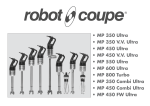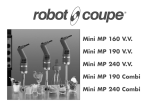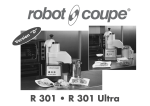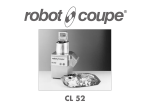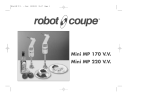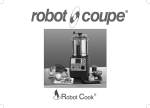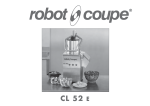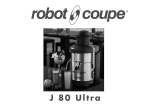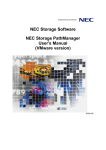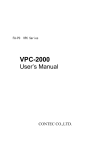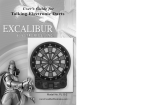Download Robot Coupe CMP 300 V.V. Specifications
Transcript
CMP 250 V.V. • CMP 300 V.V. • CMP 350 V.V. CMP 250 Combi • CMP 300 Combi SUMMARY WARRANTY IMPORTANT WARNING INTRODUCTION TO YOUR NEW POWER MIXER SWITCHING ON THE APPLIANCE • Advice on electrical connections OPERATING THE APPLIANCE • Starting and stopping the power mixer • Continuous operation • Variable-speed operation WORKING POSITION • Blade function • Whisk function ASSEMBLING / DISMANTLING CLEANING • Motor unit • Foot and bell • Blades • Whisk holder • Whisks MAINTENANCE • Blades • Whisks • Foot seal • Seal ring TECHNICAL SPECIFICATIONS • Weight • Dimensions • Working height • Noise level • Electrical data SAFETY • Blade function PROBLEMS • Whisk function STANDARDS USES & EXAMPLES HYGIENE TECHNICAL DATA • Electrical and wiring diagrams • Exploded views 13 ROBOT-COUPE S.N.C., LIMITED WARRANTY 2 - Labour to sharpen and/ or replacements for Your new ROBOT-COUPE appliance is warranted to the original buyer for a period of one year from the date of sale if you bought it from ROBOT-COUPE S.N.C. If you bought your ROBOT-COUPE product from a distributor your product is covered by your distributor’s warranty (Please check with your distributor terms and conditions of the warranty). The ROBOT-COUPE S.N.C. limited warranty is against defects in material and/or workmanship. blades which have become blunt, chipped or worn after a normal or excessive period of use. 3 - Materials or labour to replace or repair scratched, stained, chipped, pitted, dented or discoloured surfaces, blades, knives, attachments or accessories. alteration, addition or repair that has not been carried out by the company or an approved service agency. approved service agency. 1 - Damage caused by abuse, misuse, dropping, or other similar damage caused by or resulting from failure to follow assembly, operating, cleaning, user maintenance or storage instructions. 14 SHIPPING DAMAGES. Visible and latent defects are the responsibility of the freight carrier. The consignee must inform the carrier and consignor immediately, or upon discovery in the case of latent defects. KEEP ALL ORIGINAL CONTAINERS AND PACKING MATERIALS FOR CARRIER INSPECTION. 4 - Any 5 - Transportation of the appliance to or from an THE FOLLOWING ARE NOT COVERED BY THE ROBOT-COUPE S.N.C. WARRANTY: 8 - Neither ROBOT-COUPE S.N.C. nor its affiliated companies or any of its distributors, directors, agents, employees, or insurers will be liable for indirect damage, losses, or expenses linked to the appliance or the inability to use it. 6 - Labour charges to install or test new attachments or accessories (i.e., bowls, discs, blades, attachments) which have been arbitrarity replaced. 7 - The cost of changing direction-of-rotation of electric motors (Installer is responsible). The ROBOT-COUPE S.N.C. warranty is given expressly and in lieu of all other warranties, expressed or implied, for merchantability and for fitness toward a particular purpose and constitutes the only warranty made by ROBOT-COUPE S.N.C. France. IMPORTANT WARNING W A R N I N G KEEP THESE INSTRUCTIONS IN A SAFE PLACE WARNING: In order to limit accidents such as electric shocks or personal injury, and in order to limit material damage due to misuse of the appliance, please read these instructions carefully and follow them strictly. Reading the operating instructions will help you get to know your appliance and enable you to use the equipment correctly. Please read these instructions in their entirety and make sure that anyone else who may use the appliance also reads them beforehand. UNPACKING ASSEMBLY PROCEDURES • Carefully remove the equipment from the packaging and take out all the boxes or packets containing attachments or specific items. • Follow the various assembly procedures carefully (see page 17) and make sure that all the attachments are correctly positioned. • WARNING - some of the tools are very sharp e.g. blades, etc.. USE INSTALLATION • We recommend that you install your appliance on its wall frame. CONNECTION • Always check that your mains supply corresponds to that indicated on the identification plate on the motor unit and that it can withstand the amperage. • Never plug your appliance into the mains supply before placing it inside the preparation bowl. HANDLING • Always take care when handling the blades, as they are extremely sharp. • Never try to override the safety systems. • Never insert an object into the preparation. • Never switch the appliance on unless it has been placed in the preparation bowl. • Before dismantling the foot and bell, always check that the power mixer is unplugged. • We recommend that you tilt the appliance at a slight angle to prevent the bell from touching the bottom of the container. CLEANING • As a precaution, always unplug your appliance before cleaning it. • Always clean the appliance and its attachments at the end of each cycle. • Never place the motor unit in water. • For parts made from aluminum, use cleaning fluids intended for aluminum. • For plastic parts , do not use detergents that are too alkaline (e.g., containing too much caustic soda or ammonia). • Robot-Coupe can in no way be held responsible for the user’s failure to follow the basic rules of cleaning and hygiene. MAINTENANCE • Before opening the motor housing, it is absolutely vital to unplug the appliance. • Check the seals and washers regularly and ensure that the safety devices are in good working order. • It is particularly important to maintain and check the attachments since certain ingredients contain corrosive agents, e.g. citric acid. • Never operate the appliance if the power cord or plug has been damaged or if the appliance fails to work properly or has been damaged in any way. • Do not hesitate to contact your local Maintenance Service if something appears to be wrong. 15 INTRODUCTION TO YOUR NEW POWER MIXER Robot-Coupe has developed a whole range of power mixer. Their technical characteristics are shown in the table below. Models Speed variation Mixer attachment Whisk capacity attachment Litres CMP 250 V.V. • 250 mm 15 CMP 300 V.V. • 300 mm 30 CMP 350 V.V. • 350 mm 45 CMP 250 Combi • 250 mm 220 mm 15 CMP 300 Combi • 300 mm 220 mm 30 These models are working tools that are perfectly suited to the needs of their users. The mixer function will allow you to make soups, vegetable purées and pulps without any problem, while you will find that the whisk function is ideal for making pancake batter, mayonnaise, beaten egg whites, chocolate mousse, butter sauces, whipped cream or smooth fromage frais. The whisk attachment is equipped with a metallic gear box with a plastic body, even more resistant when processing preparations such as pan cakes. The variable-speed function will enable you to adjust the speed to suit each preparation and to start the processing at a lower speed in order to reduce splashing. 16 The simple design of these appliances allows the assembly and dismantling of the moving parts in no time at all, to ease maintenance and cleaning. These instructions contain important information that will enable you to extract the greatest return on your investment. We therefore strongly advise you to read these instructions carefully before using the appliance. SWITCHING ON THE APPLIANCE • ADVICE ON ELECTRICAL CONNECTIONS This class II appliance (double insulation) requires a single-phase alternating current but does not need an earthed socket. The universal-type motor is fitted with an interference suppressor. The power supply must be protected by a differential circuit breaker and a 10 A fuse. Check that you have a standard 10/16 A singlephase socket. Make sure that the voltage of your power supply matches that shown on the identification plate of your appliance. Robot-Coupe supplies these models with different types of motors: 230 V / 50 Hz for power supplies of: 220 to 240 V. OPERATING THE APPLIANCE • STARTING AND STOPPING THE POWER MIXER 1. Check that the control button (CB) is in the released position. 2. Connect the power mixer to the power supply. 3. Insert the foot into the preparation. 4. Press and hold down the safety button (SB). 5. Press the control button (CB), and the power mixer will start up. 6. Release the safety button (SB). 7. To stop the power mixer, release the control button (CB). SB VB CB LB • CONTINUOUS OPERATION Follow steps 1 to 6 above, then: 7. While the control button (CB) is in the depressed position, press the locking button (LB) 8. Release the control button (CB). 9. Release the locking button (LB), and the power mixer will function continuously. 10. To stop the power mixer, press and release the control button (CB). 120 V / 60 Hz. • VARIABLE-SPEED OPERATION 220 V / 60 Hz. Follow steps 1 to 6 above, then: 7. Change the speed of the motor by turning the variable speed button (VB) towards the maximum or minimum as required. The power mixer is supplied with a single-phase plug connected to a power cord. Whisk function : speed between 500 and 1800 rpm. • WHISK FUNCTION Mixer function : speed between 2300 and 9600 rpm. You can also hold the appliance by the handle with one hand, leaving the other hand free to hold the bowl, if necessary. While you process the preparation, we recommend that you move the whisks around in the bowl, in order to ensure that the mixture is completely homogeneous. We strongly advise you to keep the whisks from touching the sides of the bowl. For maximum efficiency, at least onefifth of the whisk length should be immersed. We also strongly advise you to start the processing at a low speed. It is advisable to start at a low speed when using the whisk. With the self-regulating speed system, once you have selected a speed, it will remain constant, even if the consistency of your mixture changes. WORKING POSITION • BLADE FUNCTION For greater control, we recommend that you hold the power mixer by the handle and the bottom of motor unit. Furthermore, we recommend that you tilt the power mixer at a slight angle to prevent the bell from touching the bottom of the container. The power mixer can equally be rested against the rim of the container, but must be tilted, and the bell must not touch the bottom of the container. Always make sure that the bell is sufficiently immersed to avoid splashing and that the air vents of the motor unit does not come into contact with any liquid. For optimum efficiency, two thirds of the foot should be immersed in the preparation. E C B A D Removing the tube from the motor unit (only for CMP Combi) - Check that the appliance is unplugged. - Turn the tube in the opposite direction to that used when attaching it. - When it will go no further, remove the tube of the aluminium casing. Attaching the bell from the tube ASSEMBLING / DISMANTLING TURN TO ATTACH BELL • BLADE FUNCTION Attaching the tube to the motor unit. (only for CMP Combi) - Check that the appliance is not plugged in. - Align the flat side of A the conical part of the tube with catch B into the aluminium casing. - Insert the whole of the conical part C of the tube into the aluminium casing. - Turn the tube in the direction of the arrow (see figure) until it is locked into place moderately tightly. - Check that the machine is not plugged in. - Align the flat side of A the conical part of the tube with catch B he inside of the bell. 17 - Insert the conical part C into the bell. With the washer touching the tube seal D , turn the bell in the direction of the arrow (see above figure) to lock the bell lug E and tube lug F together moderately tightly. BLADE LOCKING Removing the casing BLADES WITH WATERTIGHT SEALS - Check that the machine is not plugged in. - Turn the whisk holder in the opposite direction to that used when attaching it. - When it will go no further, remove the whisk holder from the aluminium casing. BELL Removing the bell from the tube - Check that the machine is not plugged in. - Turn the bell in the direction of arrow 1 (see next figure) to separate the bell lug E from the tube lug F . Remove the bell. - If jammed, turn the blades inside the bell in the direction of arrow 2 to disengage them from the drive shaft. - Turn the whisk holder in the direction of the arrow (see figure) until it is locked into place moderately tightly. DRIVE COUPLING BLADE REMOVAL Fitting the whisks into the whisk holder • WHISK FUNCTION (only for CMP Combi) TURN TO REMOVE BELL 1 C C B D E TURN TO DISENGAGE BLADES 2 A A B F Removing the blade - To remove the blade safely, hold them with the tool provided or an oven glove or a thick cloth. - Using the removal tool, unscrew the drive coupling. - As soon as the drive coupling has been unscrewed, the blade can be removed for cleaning. 18 E Attaching the whisk holder to the motor unit. - Check that the machine is not plugged in. - Align the flat side A of the conical part C of the whisk holder with the catch B on the inside of the aluminium casing. - Insert the whole of the conical part C of the whisk holder into the aluminium casing. - Grasp the holder in one hand. - With the other hand, take the first whisk and insert the shaft A into the bore B of the whisk holder drive shaft. Make sure the drive lugs D are properly aligned with the notches. - As you push the whisk into the whisk holder drive shaft C , rotate it slightly in order to slot the drive lugs into the notches D of the drive shaft C , thereby locking the whisk into place inside the shaft. - To check that the whisk is properly fixed inside the shaft C , gently tug the metal wires. - Repeat this procedure with the second whisk. If you cannot push it in properly, remove it, rotate it 90° and start again. Removing the whisks from the whisk holder Pull the ejector A in direction to the arrow, gripping the ejector in one hand and the holder B in the other. - Hold the whisk by the wires B in one hand. - With the other hand, pull the ejector A in the direction of the arrow (see figure). The foot, the blades and the whisks can be entirely dismantled, (Robot-Coupe’s exclusive patented system), thereby ensuring easy cleaning, per fect hygiene and simple maintenance. • N.B. NEVER USE PURE BLEACH - Dilute the detergent/disinfectant following the manufacturer’s instructions on the label. - Scrub well if necessary. - Leave the disinfectant/detergent to take effect if necessary. - Rinse thoroughly. - Dry properly using a clean cloth. CLEANING CATERING AND RESTAURANT WORK AT T E N T I O N Blade Function • Vegetable purees : carrots, spinach, celery, turnips, French beans, etc. • Mousses : vegetable, fish • Fruit compotes • Sauces : green, rouille, remoulade, cream emulsions, tomato or parsley • Bisques : langoustines and shellfish • Pancake batter B Removing the ejector A The mixer function makes it possible to carry out all types of processing in the minimum of time, while the whisk function enables you to whisk and mix the preparation. We thus recommend that you supervise all food preparations carefully in order to obtain the best results. • Soups A B USES & EXAMPLES Whisk function • Mashed potatoes (fresh or instant). • Pancake batter • Mayonnaise • Beaten egg whites • Chocolate mousse • Butter sauces • Whipped cream • Smooth fromage frais • Mashed potato (fresh or instant) As a precaution, always unplug your appliance before cleaning it (risk of electrocution). After using the power mixer in a hot preparation, cool the bottom of the foot in cold water before dismantling the bell from the foot. After completion of preparation, clean immediately to prevent food from sticking to surfaces. • MOTOR UNIT Never put the motor unit and its handle in water, clean them with a damp cloth or a sponge. • FOOT AND BELL CHEMICAL & PHARMACEUTICAL LABORATORY WORK • Mixing : making ointments, creams, paste…, emulsions. HYGIENE The equipment must be clean at all stages of production. It is vital to clean the power mixer thoroughly between each job using a detergent or disinfectant It is possible to proceed in two ways: • Simple cleaning procedure - Place the foot and bell into a suitable container with water and switch on for a few seconds to clean the bell and the foot. - After unplugging the appliance – essential –, making sure that no water finds its way into the foot, detach the bell from the foot to avoid a build-up of condensation. • Complete cleaning procedure - Unplug the power mixer. - Rinse the bell under the tap. 19 - Remove the bell from the foot, then remove the blades. Be careful to avoid damaging the surface of the blade shaft and the watertight seals. Do not use too strong a detergent when cleaning the parts. - Ensure that all the different parts are thoroughly dried before reassembly. • BLADES The blades can be removed from the bell for thorough cleaning. Always dry the blades thoroughly after cleaning to avoid spotting. • WHISK HOLDER Never immerse the whisk holder in water. Clean it with a slightly damp cloth or sponge. Never clean the whisk holder in a dishwasher. • WHISKS The whisks can be cleaned either by hand or in a dishwasher. To ensure effective cleaning, we advice you to remove the whisk ejector. You are also advised to change, at the same time, the washer and the watertight seals. • WHISKS MAINTENANCE • BLADES The performance of the cut essentially depends on the state of your blades and their wear. The blades are subject to wear and as such need to be replaced from time to time to ensure the consistent quality of the end product. 20 CMP 250 V.V. The success of your preparation will depend essentially on the state of the metal wires and their amount of wear and tear. They should therefore be replaced from time to time in order to ensure optimum quality of the finished product. CMP 300 V.V. CMP 350 V.V. A = 094 B = 610 C = 090 D = 255 A = 094 B = 660 C = 090 D = 305 A = 094 B = 718 C = 090 D = 363 A B • FOOT SEAL CMP 250 Combi CMP 300 Combi In order to maintain a perfect watertight seal between the foot and the bell it is necessary to check the wear of the seal regularly and replace it if necessary. E • WASHER The washer can be greased using a suitable food safe lubricant. In order to maintain a perfect watertightness it is necessary to check the wear of the washer, and if necessary, to replace it. I M P O R T A N T Check that your detergent is suitable for cleaning plastic parts. Some washing agents are too alkaline (e.g. high levels of caustic soda or ammonia) and totally incompatible with certain types of plastic, causing them to deteriorate rapidly. • DIMENSIONS (en mm) TECHNICAL SPECIFICATIONS • WEIGHT C A = 094 B = 640 C = 090 D = 300 E = 390 F = 120 A = 094 B = 700 C = 090 D = 350 E = 390 F = 120 F • WORKING HEIGHT We recommend that you ensure that the container is placed on a stable and solid work surface. • NOISE LEVEL The equivalent continuous sound level when the foot is not immersed in anything is less than 70 dB (A). • ELECTRICAL DATA Net weight Gross weight CMP 250 V.V. 3,0 kg 4,7 kg CMP 300 V.V. 3,1 kg 4,8 kg CMP 350 V.V. 3,3 kg 5,0 kg CMP 250 Combi with mixer with whisk 3,1 kg 3,4 kg 6,6 kg CMP 300 Combi with mixer with whisk 3,2 kg 3,4 kg 6,7 kg Single-phase machine CMP 250 V.V. / CMP 250 Combi Motor Mixer Speed (rpm) Whisk Speed (rpm) Power (Watts) Intensity (Amp.) 230 V/50 Hz 2300 to 9600 500 to 1800 270 1.1 120 V/60 Hz 2300 to 9600 500 to 1800 240 2.0 220 V/60 Hz 2300 to 9600 500 to 1800 230 1.0 Single-phase machine CMP 300 V.V. / CMP 300 Combi • Thermal and overload protection Motor Mixer Speed (rpm) Whisk Speed (rpm) Power (Watts) Intensity (Amp.) 230 V/50 Hz 2300 to 9600 500 to 1800 300 1.4 120 V/60 Hz 2300 to 9600 500 to 1800 280 2.6 220 V/60 Hz 2300 to 9600 500 to 1800 270 1.3 Single-phase machine CMP 350 V.V. Motor Mixer Speed (rpm) Power (Watts) Intensity (Amp.) 230 V/50 Hz 2300 to 9600 350 1.6 120 V/60 Hz 2300 to 9600 320 2.9 220 V/60 Hz 2300 to 9600 290 1.4 SAFETY WA R N I N G The blades are sharp tools, handle them with care. ROBOT-COUPE power mixers are equipped with a safety system comprising of a : - safety control button - safeties on motor: thermal and overload protection - no volt release safety. • Safety control button This safety mechanism prevents any unintentional starting of the power mixer. In fact, it is necessary to press down two buttons to start the power mixer. In order to start the machine, read the paragraph entitled OPERATING THE APPLIANCE (page 16). If there is an obstruction in the container (a spoon or utensil) or the machine is exposed to over use / overload, the thermal safety mechanism automatically stop the motor. In this case, wait for the power mixer to cool down completely before restarting, see paragraph entitled OPERATING THE APPLIANCE (page 16). • No volt release a supply failure In the event of a power cut or after the machine has been unplugged, the power mixer will not restart by itself. It is necessary to follow the steps in the paragraph entitled OPERATING THE APPLIANCE (page 16). R E M I N D E R Never tr y to override the locking and safety mechanisms. Never insert an object into the preparation. Never switch the appliance on unless it has been placed in the preparation bowl. Before dismantling the foot and bell, always check that the power mixer is unplugged. We recommend that you tilt the power mixer at a slight angle to prevent the bell from touching the bottom of the container. PROBLEMS At first, try to identify precisely what has caused the power mixer to stop. • If it is due to a powercut if the appliance has been unplugged - Release the control button (CB). - Check the power supply. - Restart the power mixer following the paragraph entitled OPERATING THE APPLIANCE (page 16). • If it is due to overheating of the machine - Release the control button (CB). - Unplug the power mixer. - Wait a few minutes for the motor to cool down and the thermal safety mechanism to be reset. - Restart the power mixer following the paragraph entitled OPERATING THE APPLIANCE (page 16). • If you cannot locate the cause of the problem - Release the control button (CB).- Unplug the power mixer. - Check : - the plug - that the blades are free to rotate in the bell, - the state of the power cord, - that the drive shaft is free to rotate. To do this, remove the bell and test the rotation of the end of the drive shaft manually. STANDARDS MACHINES IN COMPLIANCE WITH: • The following European directives and related national legislation: - Modified "machinery" directive 98/37/EEC, - "Low voltage" directive 73/23/EEC, - "EMC" directive 89/336/EEC, - "Materials and parts in food contact" directive 89/109/EEC, - "Plastic materials and parts in food contact" directive 90/128/EEC. • The following European harmonized standards and standards setting out health and safety rules: • We certify that the Mini MP 170 V.V. and Mini MP 220 V.V. comply with the essential requirements of the standard EN 292 – 1 and 2: machine safety – general design principles - EN 60204 -1 (1992), 21 74 75 77 78 79 81 82 83 85 86 87 89 90 91 93 95 MADE IN FRANCE BY ROBOT-COUPE S.N.C. Export Department Tel. : + 33 1 43 98 88 33 - Fax : + 33 1 43 74 36 26 18, rue Clément Viénot - BP 157 94305 Vincennes Cedex - France http://www.robot-coupe.com - email : [email protected] We reserve the right to alter at any time without notice the technical specifications of this appliance. © All rights reserved for all countries by: ROBOT-COUPE S.N.C. Réf. 450 093 - 09/2003 - CMP 250 V.V. • CMP 300 V.V. • CMP 350 V.V. • CMP 250 Combi • CMP 300 Combi FABRIQUÉ EN FRANCE PAR ROBOT-COUPE S.N.C. Administration Commerciale France Agence de Service Après-Vente & Service Après-Vente pour la Région Parisienne Tél. : 03 85 69 50 00 - Fax : 03 85 69 50 07 Tél. : 01 43 98 88 15 - Fax : 01 43 74 36 26 12, avenue du Maréchal Leclerc - BP 134 13, rue Clément Viénot 71305 Montceau-en-Bourgogne Cedex 94305 Vincennes Cedex email : [email protected]



























